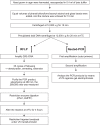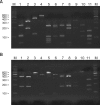Comparison of Nested PCR and RFLP for Identification and Classification of Malassezia Yeasts from Healthy Human Skin
- PMID: 20523823
- PMCID: PMC2861263
- DOI: 10.5021/ad.2009.21.4.352
Comparison of Nested PCR and RFLP for Identification and Classification of Malassezia Yeasts from Healthy Human Skin
Abstract
Background: Malassezia yeasts are normal flora of the skin found in 75~98% of healthy subjects. The accurate identification of the Malassezia species is important for determining the pathogenesis of the Malassezia yeasts with regard to various skin diseases such as Malassezia folliculitis, seborrheic dermatitis, and atopic dermatitis.
Objective: This research was conducted to determine a more accurate and rapid molecular test for the identification and classification of Malassezia yeasts.
Methods: We compared the accuracy and efficacy of restriction fragment length polymorphism (RFLP) and the nested polymerase chain reaction (PCR) for the identification of Malassezia yeasts.
Results: Although both methods demonstrated rapid and reliable results with regard to identification, the nested PCR method was faster. However, 7 different Malassezia species (1.2%) were identified by the nested PCR compared to the RFLP method.
Conclusion: Our results show that RFLP method was relatively more accurate and reliable for the detection of various Malassezia species compared to the nested PCR. But, in the aspect of simplicity and time saving, the latter method has its own advantages. In addition, the 26S rDNA, which was targeted in this study, contains highly conserved base sequences and enough sequence variation for inter-species identification of Malassezia yeasts.
Keywords: 26S rDNA PCR-RFLP; Malassezia yeasts; Molecular biological classification; Nested PCR.
Figures



Similar articles
-
Molecular analysis of malassezia microflora on the skin of the patients with atopic dermatitis.Ann Dermatol. 2010 Feb;22(1):41-7. doi: 10.5021/ad.2010.22.1.41. Epub 2010 Feb 28. Ann Dermatol. 2010. PMID: 20548879 Free PMC article.
-
The Investigation on the Distribution of Malassezia Yeasts on the Normal Korean Skin by 26S rDNA PCR-RFLP.Ann Dermatol. 2009 Feb;21(1):18-26. doi: 10.5021/ad.2009.21.1.18. Epub 2009 Feb 28. Ann Dermatol. 2009. PMID: 20548850 Free PMC article.
-
Identification of Malassezia species from patient skin scales by PCR-RFLP.Clin Microbiol Infect. 2002 Mar;8(3):162-73. doi: 10.1046/j.1469-0691.2002.00383.x. Clin Microbiol Infect. 2002. PMID: 12010171
-
Malassezia-Associated Skin Diseases, the Use of Diagnostics and Treatment.Front Cell Infect Microbiol. 2020 Mar 20;10:112. doi: 10.3389/fcimb.2020.00112. eCollection 2020. Front Cell Infect Microbiol. 2020. PMID: 32266163 Free PMC article. Review.
-
Progress in Malassezia Research in Korea.Ann Dermatol. 2015 Dec;27(6):647-57. doi: 10.5021/ad.2015.27.6.647. Epub 2015 Dec 7. Ann Dermatol. 2015. PMID: 26719632 Free PMC article. Review.
Cited by
-
The Prevalence and Species Composition of Malassezia yeasts in Patients with Clinically Suspected Onychomycosis.Med Arch. 2015 Apr;69(2):81-4. doi: 10.5455/medarh.2015.69.81-84. Epub 2015 Apr 6. Med Arch. 2015. PMID: 26005253 Free PMC article.
-
Molecular analysis of malassezia microflora on the skin of the patients with atopic dermatitis.Ann Dermatol. 2010 Feb;22(1):41-7. doi: 10.5021/ad.2010.22.1.41. Epub 2010 Feb 28. Ann Dermatol. 2010. PMID: 20548879 Free PMC article.
-
Skin Fungi from Colonization to Infection.Microbiol Spectr. 2017 Jul;5(4):10.1128/microbiolspec.funk-0049-2016. doi: 10.1128/microbiolspec.FUNK-0049-2016. Microbiol Spectr. 2017. PMID: 28721846 Free PMC article. Review.
-
Distribution of Malassezia species on healthy human skin in Bosnia and Herzegovina: correlation with body part, age and gender.Iran J Microbiol. 2014 Aug;6(4):253-62. Iran J Microbiol. 2014. PMID: 25802709 Free PMC article.
-
Topographical and physiological differences of the skin mycobiome in health and disease.Virulence. 2017 Apr 3;8(3):324-333. doi: 10.1080/21505594.2016.1249093. Epub 2016 Oct 18. Virulence. 2017. PMID: 27754756 Free PMC article. Review.
References
LinkOut - more resources
Full Text Sources

